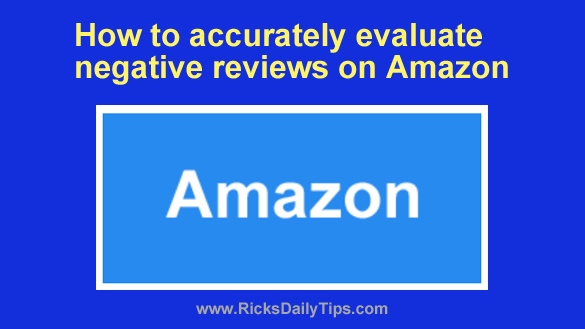
Want to get my easy to follow Tech Tips in your email?
Sign up for my daily Rick’s Tech Tips Newsletter!
Note: The links in this post are affiliate links.
Regular readers of this blog know I frequently recommend various tech products that are available on Amazon for the reasons stated in this post.
I sometimes receive emails that read something like this:
“You recommended [name of item] yesterday but you apparently neglected to read the reviews. Some of them are really bad!“
And yes, sure enough there will usually be some negative reviews for that item. After all, any item is subject to receiving negative reviews, regardless of its overall quality level.
And yes, some (or even most) of the negative reviews left for a particular item could well be warranted.
But here’s the thing about negative reviews on Amazon: They often don’t accurately reflect the actual quality of the item, for the following reasons:
1 – Most people who purchase an item don’t leave a review at all if they are happy with it. But you can bet your bottom dollar they’ll leave one if they are dissatisfied (as they rightly should).
In effect, a large number of what would have been positive reviews are never left but virtually every negative experience ends up being written up in a review.
As you can see, this gives lots of extra weight to negative reviews in the overall review process.
2 – By default, reviews on Amazon are listed with “Top Reviews” listed first. And how does Amazon determine which reviews are “Top Reviews”?
Although there are other factors in play, it’s primarily based on how many people clicked the “Helpful” button under the review.
And which reviews tend to draw the vast majority of the “Helpful” clicks? The negative ones.
3 – The overall percentage of negative reviews is more important than the number of negative reviews.
For example, I would feel completely comfortable buying an item with 30 negative reviews if 1,000 total reviews had been left for that item.
However, I wouldn’t even consider buying something with 30 negative reviews if it had only been reviewed 100 times in total.
Of course what I said above doesn’t mean negative reviews are useless and should therefore be ignored. Far from it.
Negative reviews can indeed be accurate indicators of the quality of an item if you take the following into consideration:
1 – Are the negative reviews (i.e. 3 stars out of 5 or below) a significant percentage of the amount of total reviews?
For example, 5% negative reviews out of 3,600 total reviews would be is negligible in my opinion.
2 – Are there lots of negative reviews complaining about the same thing?
If so, chances are the reviews are accurate and it might be a good idea to avoid that item.
However, if there are only a handful of negative reviews that tend to be all over the map in regards to the complaints, you can probably safely ignore them.
3 – How recent are the negative reviews?
If an item has received several negative reviews within just the last few months, there could well be something to those complaints.
Bottom line: I will never recommend an item that I don’t fully trust in regards to its quality and value.
And on the flip-side, I won’t let a relative handful of negative reviews prevent me from recommending an item either, especially if most of the negative reviews are old.
If you remember that Amazon’s procedures for evaluating and displaying user reviews gives negative reviews more weight than positive reviews, you should be just fine when deciding which items to purchase and which ones to take a pass on.
And now, a few words about fake (i.e. fraudulent) reviews…
There has been a lot of talk in the news lately about fake reviews propping up some less-than-desirable items on Amazon. And truth be told, that used to indeed be a problem.
However, a while back Amazon began cracking down on fake reviews and the problem has by and large been mitigated.
Here’s a little tip concerning fake reviews: They are usually very easy to spot. If you see that an item accumulated half or more of its positive reviews within just a one or two day time period, the odds are pretty high that those reviews are fake.
Another thing to look at is the wording. For example, do all the recent positive reviews read more or less the same? If most or all of them have similar wording and grammatical structure it’s a good bet that those reviews are fake.
Just pay attention to those details in relation to everything I said above and you’ll be able to form an accurate judgement about the quality of the item based upon the totality of the reviews that have been left for it.
Now that I’ve said everything above about evaluating their reviews, Amazon awaits!